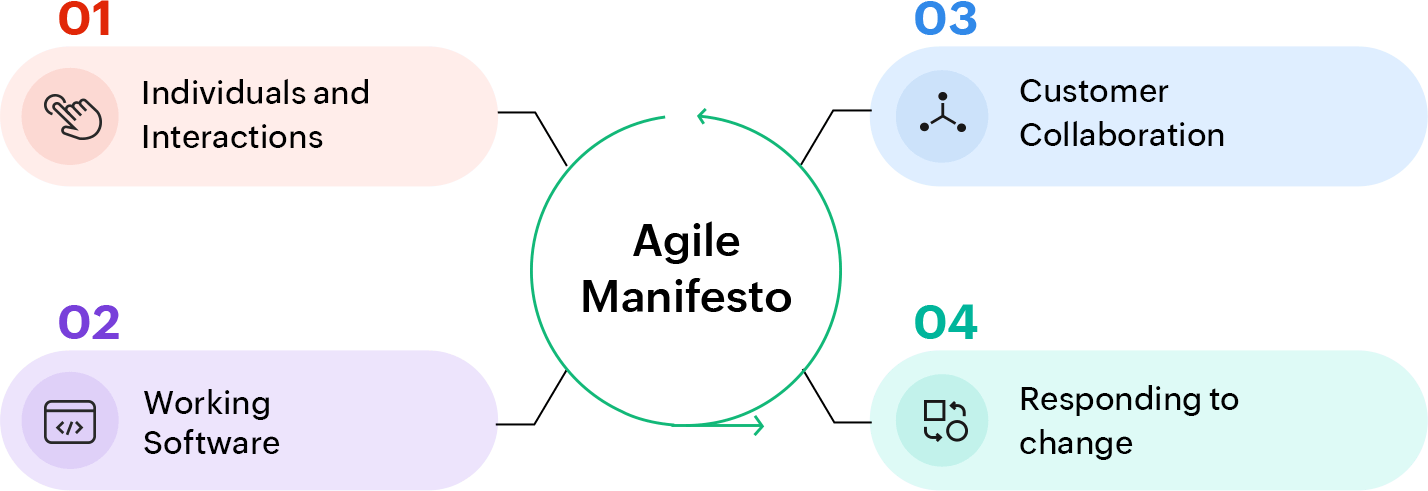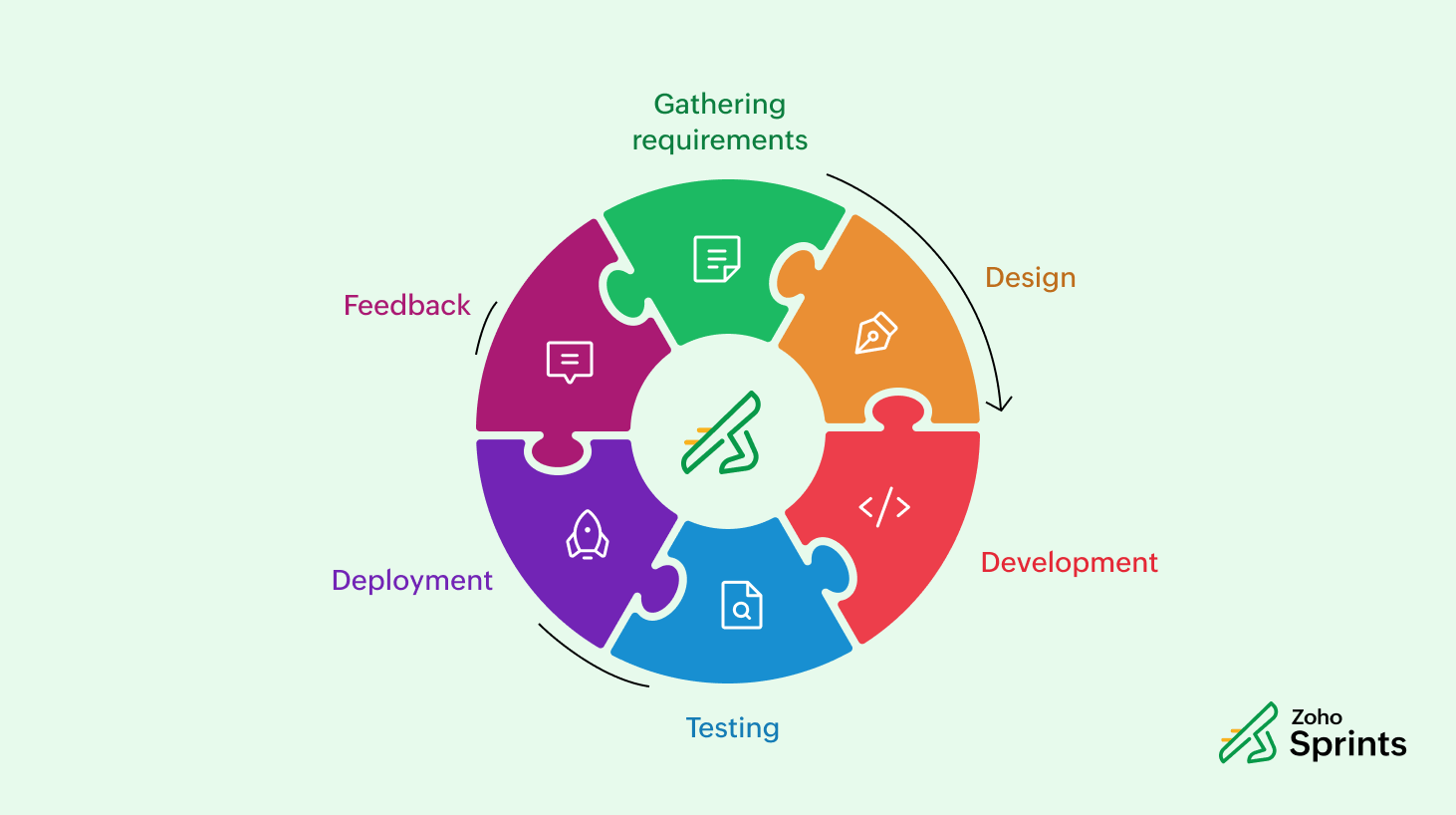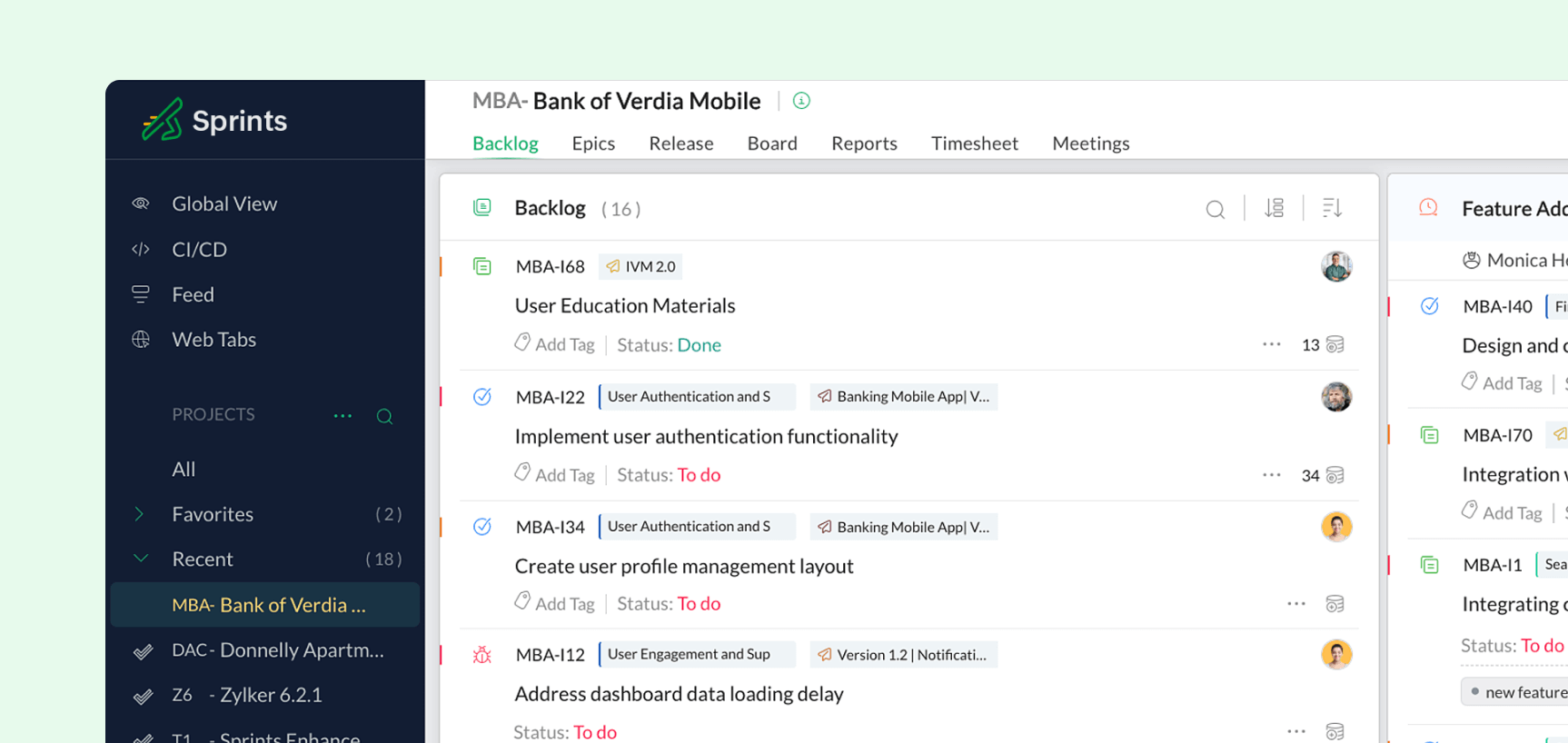History of the agile manifesto
Traditionally, software development was done using the waterfall method, which had five sequential stages: requirements gathering, design, development, testing, and deployment. By the 1990s, people were starting to realize that this model didn't hold well for long-term big-scale projects. In 2001, 17 software practitioners met at a ski lodge in Utah and decided to come up with an alternative way of working—thus agile methodology was born. The agile manifesto is a document outlining the agile way of thinking in the form of 12 principles and 4 values that form the bedrock of all the agile frameworks that exist today.
The 4 Pillars of Agile

1. Individuals and interactions over processes and tools
People drive processes, and in turn, drive the business. When team communication takes precedence over business processes and tools, it fosters greater trust, making the team more responsive and enabling them to meet customer needs.
2. Working software over comprehensive documentation
Agile methodology avoids over-documentation, as this practice has historically bogged down teams and prevented them from spending the necessary time on crafting actual working software. Any documentation should aid the team in progress and stay up-to-date as the software evolves.
3. Customer collaboration over contract negotiation
From the agile perspective, the customer is the team's most valued collaborator. Customer input should be considered throughout the entire product lifecycle, not just at the beginning or the end.
4. Responding to change over following a plan
The word "agile" implies adapting to and embracing change. Project management in agile methodology focuses on the quickest and most efficient way to release a minimum viable product. This can be adjusted and evaluated from one concise work cycle to another, also known as an agile methodology sprint.
The 12 principles of agile project management
- Our highest priority is to satisfy the customer through early and continuous delivery of valuable software.
- Welcome changing requirements, even late in development. Agile processes harness change for the customer's competitive advantage.
- Deliver working software frequently, from a couple of weeks to a couple of months, with a preference to the shorter timescale.
- Business people and developers must work together daily throughout the project.
- Build projects around motivated individuals. Give them the environment and support they need, and trust them to get the job done.
- The most efficient and effective method of conveying information to and within a team is face-to-face conversation.
- Working software is the measure of progress.
- Agile processes promote sustainable development. The sponsors, developers, and users should be able to maintain a constant pace indefinitely.
- Continuous attention to technical excellence and good design enhances agility.
- Simplicity—the art of maximizing the amount of work not done—is essential.
- The best architectures, requirements, and designs emerge from self-organizing teams.
- At regular intervals, the team reflects on how to become more effective, then tunes and adjusts its behavior accordingly.
What is agile methodology in project management?
The application of agile methodology's iterative and flexible approach to the process of project management has led to the creation of agile projects and agile project management. There are different types of agile project management styles such as Scrum, Kanban, XP, LeSS, etc. All these methods use different means to achieve a common objective, to deliver value to the customer in the fastest way possible. Visit our dedicated page on agile project management methodology for a deeper dive into these methods and other nuances of agile projects.
Benefits of agile methodology
Flexibility and Adaptability
Agile methodology not only allows but also encourages teams to adapt to changing requirements, be it from the client side or the market side. This ensures that projects and releases remain relevant despite dynamic conditions. More than a benefit, this is one of the underlying principles behind the functioning of the methodology itself.
Enhanced Output Quality
Practices such as iterative development, rigorous testing, and regular feedback cycles are quintessential in project management agile methodology. The presence of these mechanisms greatly reduces the likelihood of encountering defects or bugs.
Increased Customer Satisfaction
Customer-centricity is one of the paramount components governing the success of agile methodologies. The active involvement of both stakeholders and clients throughout the project's lifecycle culminates in an output that is closest to user expectations.
Quicker Time-to-Market
Agile frameworks emphasize on delivering tangible releases quickly through short sprint cycles (Scrum), continuous delivery flow (Kanban), scaled coordination (SAFe/LeSS), or a melange of multiple practices. Utilizing agile methodology allows organizations to deliver value faster and gain a competitive upper hand.
Stronger Team Collaboration
The importance of team communication is highlighted in the very first pillar of agile methodology. Agile by virtue fosters continuous interaction amongst the team and a self-organizing environment, leading to higher morale, more productivity, and a more creative thought process.
Disadvantages of agile methodology
Lack of Predictability
Despite also being its major boon, agile's flexible and iterative nature tends to complicate accurate estimations of cost, timelines, and resource requirements. The presence of this uncertainty factor can certain irk stakeholders. Proper tracking of metrics through instruments like burndown charts, velocity charts, etc. is required for precise estimations.
High Burden of Engagement
Continuous communication is a must have in agile projects, and it has to be across the whole spectrum of team members. This is both a very time and energy consuming exercise and mandates the use of specialized collaboration tools.
Inadequate Documentation
The second core pillar of agile directly gives preference to actual working software over comprehensive documentation. This becomes a problem during the onboarding of new members to the team or long-term product maintenance. The use of agile tools with customizable work item templates is required to capture critical knowledge, such as acceptance criteria or technical notes.
Scope Creep
Agile processes are associated with freedom and autonomy, but this can easily escalate to uncontrolled scope expansion that can put a burden on the team and its resources. Teams have to spend adequate time grooming their product backlogs before rushing into projects.
Challenges in Scaling
Applying agile methodology to large-scale projects becomes a challenge in terms of maintaining consistency. The most proven method of addressing this caveat is the application of the SAFe framework but it can get very complex for inexperienced teams. A simpler solution is to create standardized project templates across teams that can be used and adapted whenever required.
What is the difference between agile and waterfall methodologies?
The waterfall methodology proposes a linear, set approach to project management where all the variables are decided during the planning phase and the rest is merely execution. Agile methodology project management acknowledges the uncertainty that accompanies changing technologies in a fast-paced world and proposes iterative short-term planning to combat it. Work is split into small sizable chunks which are worked on consecutively. With each part comes changes in requirements or improvements in technology that make the subsequent parts more efficient and effective.
Thus, project management using agile methodology advocates constant learning and adapting in order to produce quality end products that perfectly satisfy the customer’s requirements while keeping up with current technology trends.
| Waterfall Metrodology | Agile Methodology |
|---|---|
| Linear and sequential approach | Incremental and iterative approach |
| Focuses on project delivery | Focuses on customer satisfaction |
| Delivers project in one go | Project is split into sprints |
| Requirements are taken only at the start of the process | Requirements are expected to change and evolve |
| Avoids scope changes once development begins | Incorporates changes even late in the development |
| Strict project deadlines enforced by the project manager | Teams are encouraged to be self-organizing |
| Focused on executing the plan | Focused on delivering working software |
Ready to find out if the agile way might just be your key to success? Try Zoho Sprints for free and find out today!
Get StartedAgile Software Development Cycle (Agile SDLC)
Agile SDLC is a methodology that applies the core agile principles such as flexibility, collaboration, and customer-centricity to create an incremental and iterative software development process. Traditionally, software development was also carried out through the Waterfall method. This involved extensive analysis of market or user requirements and a linear process all the way from design to development with zero scope for changes in between. The Agile SDLC overhauled this process by breaking a large project down to smaller cycles (or sprints) that usually last 2-4 weeks. This allowed organizations to release software and deliver value in the quickest possible frame of time. The Agile SDLC typically comprises the following phases-

1. Requirement Gathering
Unlike Waterfall's exhaustive upfront analysis, only goals relevant to a particular iterative cycle are identified to be worked upon. These goals are usually higher level goals that are commonly described in the form of user stories. This is done in constant collaboration with every stakeholder to pick the most coherent key requirements carefully.
2. Design
In the design phase, individual user stories are translated and broken down into actionable tasks. Developers and stakeholders collaborate to create architectural prototypes, such as wireframes or visual representations such as flow diagrams, to make sure that everyone is aligned with the plan. The key here is to provide just enough to commence with the development process while also leaving room to accommodate changes if the need arises in the future.
3. Coding
In the Agile SDLC, coding is done continuously and in increments. Instead of pushing this process to the end of a cycle, agile methodology encourages code development in short bursts, where small changes are implemented and continuously integrated into the main codebase. A working piece of software should be ready through each iteration for early validation and feedback.
4. Testing
Unlike the Waterfall SDLC where a full system test is conducted only after the entire program is ready, the Agile SDLC emphasizes testing in parallel with each iteration of code. Different types of testing methods, such as unit testing, integration testing, user acceptance testing, etc., are employed for rigorous detection of bugs or requirement mismatches
5. Deployment
Upon successful completion of testing, the validated code is released to the end users as a part of the main application. CI (Continuous Integration) and CD (Continuous Deployment) tools are often used to automate the release process. Ideally, each sprint cycle should produce a tangible release, which is exponentially faster than Waterfall, where deployment happens at the very end of the project.
6. Feedback
In the Agile SDLC, feedback is collected continuously throughout each sprint cycle. Review meetings are held at the end of each sprint, where the corresponding product increment is demonstrated to the stakeholders to garner inputs. These inputs are then fed into the planning of the next sprint cycle, facilitating continuous improvement.
Role of Agile Methodology in other industries
Agile methodology originally emerged as a means to streamline the process of software development and release. However, as markets evolved and consumer behaviors shifted, pace and adaptability became crucial factors for businesses to stay competitive. Agile methodology encourages situational adaptation, frequent introspection, and constant realignment to bring out a product or service that effectively stays attuned to the dynamic and unpredictable nature of modern day markets. Hence, a wide spectrum of industries are turning to Agile methodology not just as a framework to speed up their process but as an organization-wide mindset on the whole. Some of these non-IT industries include:
- 1. Manufacturing: Companies like Toyota, who gave birth to the concept of Lean have been using agile principles in production processes for decades, long before they were even coined under the term "agile". The presence of agile is highly beneficial in reducing waste, reducing the time-to-market, and navigating through supply chain complications.
- 2. Marketing: Agile marketing is a well documented approach that allows for quicker testing of ideas and responsive content creation that resonates with the target-audience in real-time.
- 3. Education: Established institutions like Harvard and UC Berkeley have utilized agile to design curriculum and also improve collaboration within the classroom. Project management using agile methodology was also used for improving school administration and operation.
- 4. Healthcare: Agile methodology has been increasingly adopted in the healthcare industry for enhanced patient care and faster implementation of new treatments and technology. A notable example is the UK National Health Service, which utilized agile to develop their digital health platforms that optimize communication between patients and healthcare providers.
- 5. Retail: The retail sector, agile methodology helps businesses improve supply chain efficiency and enhance customer experience, particularly in the eCommerce sector. Best Buy Canada, after adopting agile, saw an estimated $40M reduction per year in costs, an improved time to market, and increased overall revenues.
Worried about setting up agile? Zoho Sprints will take care of it.
Agile is more than just a mere process; it is a philosophy. Hence, adopting agile methodology can often feel daunting, especially for teams who haven't been exposed to its iterative and responsive nature. Keeping this in mind, we designed Zoho Sprints, anchoring around qualities of simplicity, practicality, and user-friendliness. With Sprints, our focus was directed to create a strong foundation with an emphasis on the fundamentals of agile. Simultaneously, we offer the freedom for seasoned teams to incorporate their unique processes through extensive customization.

Whether you're a startup taking your first steps into agile or a global conglomerate looking to reshape your value chain, Zoho Sprints offers the structural support you need and grows with you.